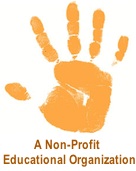Letter From The President
by Paul Robear
Greetings from down under! Laura and I are in Sydney Australia, visiting our friends Graeme and Shelley, Jane and Jacqui, and making new friends along the way as we present, talk, and demonstrate the work of CI. We are about to depart for the Outback to join Shelley and Graeme’s on their tour of the Outback and Uluru (aka Ayers Rock) — we will have a full report next issue.
In our increasingly virtual world, we are challenged with losing connection with the natural world and all of its wonders that surround us. Are we are becoming so wired technologically that our human identity that defines us could be facing a crisis? Here are a few interesting facts I found:
• Social networking now eats up more than three hours of the average American’s day.
• Google logs more than one billion searches each day.
• Sixty hours of content gets uploaded to YouTube every minute
• More than 800 million updates are recorded daily on Facebook.
While its acknowledged that social media is leaving a marked shift in the way we think and behave, particularly among the youth, we are so immersed in all our modern tech that we often fail to realize how much it is shaping us, and in ways we have yet to realize.
We are certainly enjoying the many wonders of technology, but let’s not ignore our need for the natural world, and how it has shaped us over the arc of the human story. We have an inbuilt need, and access to, our bodies are designed—“hardwired”—for the experience of ecstasy. Our very physiology is designed to easily access this state all on its own, no outside agents required.
Dr. Felicitas Goodman felt that our chronic condition of ecstasy deprivation is an underlying factor in many addictions. She researched and explored Ritual Postures as a means to activate the body’s inbuilt means to restore balance and activate the creative core of ecstatic states of being. It seems to me our growing addiction to outer technology is further displacing our ancestral knowledge of our inner technology. As we get further away from our indigenous roots, we risk losing touch with some of the key aspects that make us human. It is the old ways that beckon as we increasingly acknowledge the need to return to balance, individually and collectively. It is our mission to participate in this need of creating balance and a re-connection to the wisdom traditions of our ancestors.
In this issue: This months featured article comes from Stephen Wall (White Earth Reservation) is Chair of the Indigenous Liberal Studies Department at the Institute of American Indian Arts. In this article”Indigenous as a Way of Life” Mr. Wall points out that all humans need to see themselves as indigenous to planet. He quotes John Mohawk from the book “Original Instructions: Indigenous Teachings for a Sustainable Future” :
- “I think that when we talk about re-indigenization we need a much larger, bigger umbrella to understand it. It’s not necessarily about the Indigenous people of a specific place; it’s about re-indigenizing the peoples of the planet to the planet.”
With this definition in mind, we all share the responsibility of being indigenous.
Also in this issue: Laura Lee shares her research on how the oldest masks tell their story. The use of a mask during ritual is found both ancient and modern cultures in all parts of world. While the earliest masks we have are 9,000 years old, the making of masks, as part of the Shamanic Tradition depicted in ancient art, dates back 35,000 years.
Have questions or comments or research of your own to share? Reach me directly at paulrobear@cuyamungueinstitute.com. We welcome all correspondence.
Paul Robear
President / Executive Director
Cuyamungue: The Felicitas D. Goodman Institute
I am happy to share the following news and articles.
- Article: Indigenous as a Way of Life: by Stephen Wall
- Article: What’s in a Mask? Part 1: The Oldest Masks Tell Their Story by Laura Lee
- News: Welcome our New Board Member: Cecilia Stanford
- News: Out & About by Laura Lee
SCROLL DOWN for Articles and Links
![]()
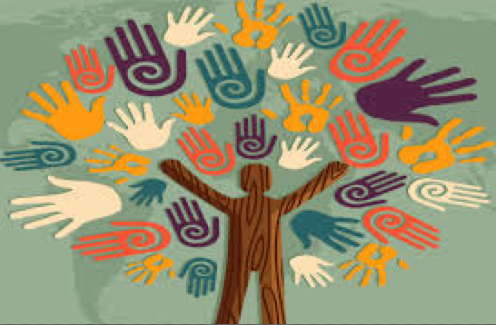 Indigenous as a Way of Life
Indigenous as a Way of Life
by Stephen Wall
Indigenization is the connection between the people and the land on which they live. Regardless of ancient astronaut theories, humans are indigenous to planet Earth and have, over thousands of years, developed ways of life that existed in relative balance with the places of their habitation. While examples of overuse of resources, forced migrations and population die-offs exist, when we consider the extent of human habitation, these occurrences, while devastating, have not been the norm in human history. Indigeneity has meant living within the limits of resources, exercising reciprocity and acknowledging relationships that existed within the confines of a particular bio-region or ecological niche. —————–> Full Article![]()
What’s in a Mask? Part 1: The Oldest Masks Tell Their Story
by Laura Lee
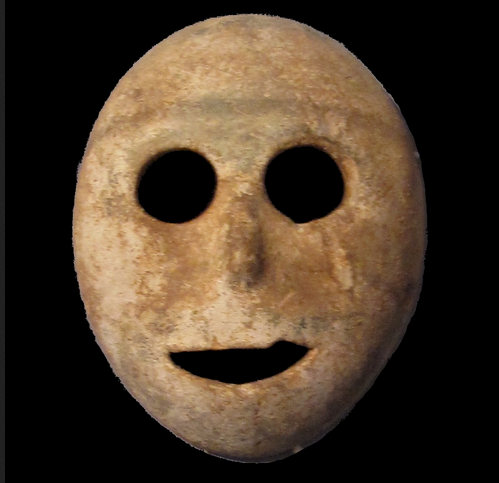 The world’s oldest known mask eerily resembles our modern and ubiquitous “smiley face” — though this elder manages to strike a bit more pensive and thoughtful a pose. Pretty good for being nine thousand years old. All date to the same era, verified with micro-archaeology techniques that included testing surface sediment and examining their crystalline structure and mineralogical composition under the microscope. What makes these masks, and not simply portraits? Small circular holes, neatly carved along the edge of many of these masks, seem handy for insertion of cordage to secure onto the head —————-> Full Article
The world’s oldest known mask eerily resembles our modern and ubiquitous “smiley face” — though this elder manages to strike a bit more pensive and thoughtful a pose. Pretty good for being nine thousand years old. All date to the same era, verified with micro-archaeology techniques that included testing surface sediment and examining their crystalline structure and mineralogical composition under the microscope. What makes these masks, and not simply portraits? Small circular holes, neatly carved along the edge of many of these masks, seem handy for insertion of cordage to secure onto the head —————-> Full Article
![]()
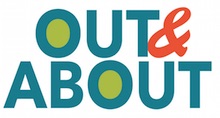 Out and About – October 2015 by Laura Lee
Out and About – October 2015 by Laura Lee
Editors Note: One of the rewards of directing the Institute is that Laura and I meet so many fascinating people, and fun adventures continue to come our way. I asked Laura to gather up some of these stories, conversations and activities and share them in the newsletter from time to time. This is the second edition of “Out & About”. ————-> Complete Article
![]()
 Welcome our New Board Member: Cecilia Stanford
Welcome our New Board Member: Cecilia Stanford
In 1987 I met Dr. Goodman in San Diego, and took the first steps on a path that was life changing. I traveled to the Institute and participated in the posture work beginning in 1989 and continued through 1992. In San Diego, I led a posture group, and hosted an intensive weekend with Dr. Goodman and postures. Then a working Life intervened, until now, where I find myself free to devote time to projects that call to me, and recently return to Cuyamungue to attend an Advanced Initiatory Training and Masked Trance Dance.
My background includes a BFA in Theater Arts, emphasis on the History of Fashion and Patterning, and 25 years as a professional costumer, primarily for San Diego Opera. For the past 15 years, I have been a self employed studio artist, specializing in handmade ceramic mosaic sculpture, and more recently, elaborate embroidered textile assemblage. I have lived in southwestern New Mexico for 15 years, and love to promote this beautiful state.
![]()
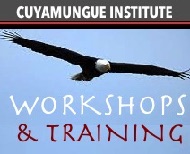 2016 Workshops, Events and Training at Cuyamungue:
2016 Workshops, Events and Training at Cuyamungue:
Each workshop contains a specifically designed series of ritual postures to provide the context for a journey of self-discovery. We go deep within utilizing the Cuyamungue Method – which includes a established ritual journey method. Introductory workshops are are prerequisites for advanced classes.
Here is the preview of workshops and events in development for 2016 at the Cuyamungue Institute, so you can get the jump-start on making your plans to join us next season. There may be adjustments to dates, times and details, and additional events and workshops will be added. Much more detail to follow in the near future.
![]()
April 30th / May 1st, 2016 – Maypole Celebration
May 26 – 29, 2016 – Board of Directors Meeting
June 17th – 21st , 2016 – Initiatory Training
July 20th – 24th , 2016 – Initiatory Training
August 3 – 7, 2016 – Initiatory Training – Advanced Course
August 16 – 21, 2016 – Instructor Training – Contact us
August 23 – 28, 2016 –Men’s Conclave Contact us
September 21st – 25th , 2016 Masked Trance Dance – Contact us
The Cuyamungue Institute, like many non-profit organizations, has limited resources. We are proud of the scope of work we have already accomplished. However, there is much more to do, and we depend upon your support. We always use our all resources with great care. Our focus and key priority to continue to ensure the financial stability of CI for the future.
There are several ways to participate:
- Attend workshops at the Institute – Bless yourself and the Institute! Workshop fees directly support the land and buildings.
- Be a Volunteer – Ask about existing, on-going projects you can help with. Or suggest projects that you can work on, fund, or both!
- Personal Donations – 100% of your donations and gifts go directly to the Institute, and are tax deductible.
- Corporate Donations – Your company can have a tremendous impact. Also ask us how we can bring our work to your company!
- Planned Giving – Including the Cuyamungue Institute in your estate plans can help you accomplish a charitable goal while realizing potential significant tax savings and supporting the future of the Cuyamungue Institute. More Information
Please consider making a donation by clicking here. Ongoing research and new applications of this work with Ritual Postures is only possible because of donations made by people like you. Laura Lee, our Director of Outreach and Development, is available to answer your questions and to provide more information. Contact her at lauralee@cuyamungueinstitute.com
![]() How to Submit an Article: As part of expanding our Cuyamungue Institute community, you are invited and encouraged to participate. Share how you use the Cuyamungue Method in your chosen field. We are also open to other topics, with the emphasis on the posture work, and research and or experience. More information
How to Submit an Article: As part of expanding our Cuyamungue Institute community, you are invited and encouraged to participate. Share how you use the Cuyamungue Method in your chosen field. We are also open to other topics, with the emphasis on the posture work, and research and or experience. More information
![]()
![]() Thanks for reading! Please forward this to your friends and acquaintances who will enjoy learning more about us, and please let me hear from you! I am most happy answer any and all questions about the Institute or the Cuyamungue Method. We welcome all correspondence. Not already subscribed? Subscribe Here.
Thanks for reading! Please forward this to your friends and acquaintances who will enjoy learning more about us, and please let me hear from you! I am most happy answer any and all questions about the Institute or the Cuyamungue Method. We welcome all correspondence. Not already subscribed? Subscribe Here.
Email me directly at paulrobear@cuyamungueinstitute.com . 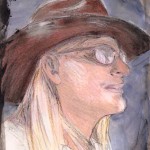
Blessings,
Paul Robear
President / Executive Director
Cuyamungue – The Felicitas D. Goodman Institute


